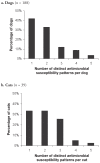Occurrence of antimicrobial resistant bacteria in healthy dogs and cats presented to private veterinary hospitals in southern Ontario: A preliminary study
- PMID: 20046603
- PMCID: PMC2748285
Occurrence of antimicrobial resistant bacteria in healthy dogs and cats presented to private veterinary hospitals in southern Ontario: A preliminary study
Abstract
The prevalence and patterns of antimicrobial susceptibility of fecal Escherichia coli, Salmonella spp., extended beta-lactamase producing E. coli (ESBL-E. coli), methicillin-resistant Staphylococcus aureus (MRSA), and methicillin-resistant Staphylococcus pseudintermedius (MRSP) were determined for healthy dogs (n = 188) and cats (n = 39) from veterinary hospitals in southern Ontario that had not had recent exposure to antimicrobials. The prevalence of antimicrobial resistance in E. coli was as follows: streptomycin (dogs - 17%, cats - 2%), ampicillin (dogs - 13%, cats - 4%), cephalothin (dogs - 13%, cats - < 1%), and tetracycline (dogs - 11%, cats - 2%). Eleven percent of dogs and 15% of cats had isolates that were resistant to at least 2 antimicrobials. Cephamycinase (CMY)-2 producing E. coli was cultured from 2 dogs. No Salmonella spp., ESBL-E. coli, MRSA, or MRSP isolates were recovered. The observed prevalence of resistance in commensal E. coli from this population was lower than that previously reported in companion animals, but a small percentage of dogs may be a reservoir for CMY-2 E. coli.
Fréquence des bactéries résistantes aux antimicrobiens chez les chiens et chats en santé présentés dans des cliniques vétérinaires privées du Sud de l’Ontario : Une étude préliminaire. La prévalence et les tendances de sensibilité antimicrobienne d’Escherichia coli d’origine fécale, de Salmonella spp., d’E. coli producteur de bêta-lactamase à spectre élargi (BLSE-E. coli), de Staphylococcus aureus résistant à la méthicilline (SARM) et de Staphylococcus pseudintermedius résistant à la méthicilline (SPRM) ont été déterminées chez des chiens (n = 188) et des chats en santé (n = 39) présentés dans des cliniques vétérinaires du Sud de l’Ontario et qui n’avaient pas été récemment exposés à des antimicrobiens. La prévalence de la résistance antimicrobienne pour E. coli était la suivante : streptomycine (chiens — 17 %, chats — 2 %), ampicilline (chiens — 13 %, chats — 4 %), céphalothine (chiens — 13 %, chats — < 1 %) et tétracycline (chiens — 11 %, chats — 2 %). Onze pour cent des chiens et 15 % des chats présentaient des isolats qui étaient résistants à au moins 2 antimicrobiens. L’E. coli producteur de céphamycinase (CMY)-2 a été cultivé à partir de 2 chiens. Aucun isolat de Salmonella spp., de BLSE-E. coli, de SARM ou de SPRM n’a été récupéré. La prévalence observée de résistance pour E. coli commensal de cette population était inférieure aux résultats qui avaient déjà été signalés pour les animaux de compagnie, mais un faible pourcentage de chiens peut représenter un réservoir de CMY-2 E. coli.
(Traduit par Isabelle Vallières)
Figures


Similar articles
-
Carriage of methicillin-resistant staphylococci by healthy companion animals in the US.Lett Appl Microbiol. 2014 Jul;59(1):1-8. doi: 10.1111/lam.12254. Epub 2014 Apr 15. Lett Appl Microbiol. 2014. PMID: 24730724
-
Escherichia coli and selected veterinary and zoonotic pathogens isolated from environmental sites in companion animal veterinary hospitals in southern Ontario.Can Vet J. 2010 Sep;51(9):963-72. Can Vet J. 2010. PMID: 21119862 Free PMC article. Review.
-
Commensal Staphylococci Including Methicillin-Resistant Staphylococcus aureus from Dogs and Cats in Remote New South Wales, Australia.Microb Ecol. 2020 Jan;79(1):164-174. doi: 10.1007/s00248-019-01382-y. Epub 2019 May 2. Microb Ecol. 2020. PMID: 31049616
-
Diversity of Plasmids and Antimicrobial Resistance Genes in Multidrug-Resistant Escherichia coli Isolated from Healthy Companion Animals.Zoonoses Public Health. 2015 Sep;62(6):479-88. doi: 10.1111/zph.12178. Epub 2015 Feb 4. Zoonoses Public Health. 2015. PMID: 25653018
-
Multidrug-resistant opportunistic pathogens challenging veterinary infection control.Vet Microbiol. 2017 Feb;200:71-78. doi: 10.1016/j.vetmic.2016.05.017. Epub 2016 May 27. Vet Microbiol. 2017. PMID: 27291944 Review.
Cited by
-
Methicillin-resistant staphylococcal contamination of cellular phones of personnel in a veterinary teaching hospital.BMC Res Notes. 2012 Jul 10;5:193. doi: 10.1186/1756-0500-5-193. BMC Res Notes. 2012. PMID: 22533923 Free PMC article.
-
Subtyping Salmonella isolated from pet dogs with multilocus sequence typing (MLST) and clustered regularly interspaced short palindromic repeats (CRISPRs).AMB Express. 2021 Apr 24;11(1):60. doi: 10.1186/s13568-021-01221-9. AMB Express. 2021. PMID: 33893895 Free PMC article.
-
Prevalence of coagulase-positive methicillin-resistant Staphylococcus aureus and Staphylococcus pseudintermedius in dogs in Bangladesh.Vet Med Sci. 2022 Mar;8(2):498-508. doi: 10.1002/vms3.701. Epub 2021 Dec 23. Vet Med Sci. 2022. PMID: 34941011 Free PMC article.
-
Rectal swabs are suitable for quantifying the carriage load of KPC-producing carbapenem-resistant Enterobacteriaceae.Antimicrob Agents Chemother. 2013 Mar;57(3):1474-9. doi: 10.1128/AAC.01275-12. Epub 2013 Jan 7. Antimicrob Agents Chemother. 2013. PMID: 23295937 Free PMC article.
-
Investigation of prevalence and antimicrobial resistance of Salmonella in pet dogs and cats in Turkey.Vet Med Sci. 2024 Jul;10(4):e1513. doi: 10.1002/vms3.1513. Vet Med Sci. 2024. PMID: 38924270 Free PMC article.
References
-
- Vengust M, Anderson ME, Rousseau J, Weese JS. Methicillin-resistant staphylococcal colonization in clinically normal dogs and horses in the community. Lett Appl Microbiol. 2006;43:602–606. - PubMed
-
- Moodley A, Stegger M, Bagcigil AF, et al. spa typing of methicillin-resistant Staphylococcus aureus isolated from domestic animals and veterinary staff in the UK and Ireland. J Antimicrob Chemother. 2006;58:1118–1123. - PubMed
-
- Weese JS, Dick H, Willey BM, et al. Suspected transmission of methicillin-resistant Staphylococcus aureus between domestic pets and humans in veterinary clinics and in the household. Vet Microbiol. 2006;115:148–155. - PubMed
-
- De Graef EM, Decostere A, Devriese LA, Haesebrouck F. Antibiotic resistance among fecal indicator bacteria from healthy individually owned and kennel dogs. Microb Drug Resist. 2004;10:65–69. - PubMed
Publication types
MeSH terms
Substances
LinkOut - more resources
Full Text Sources
Medical
Miscellaneous
